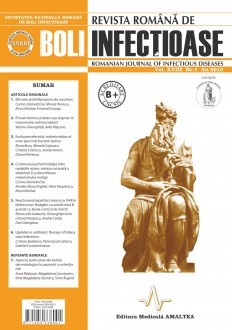SELECT ISSUE

Indexed

| |

|
|
|
| |
|
|
|

|
|
|
|
|
|
| |
|
|
HIGHLIGHTS
National Awards “Science and Research”
NEW! RJID has announced the annually National Award for "Science and Research" for the best scientific articles published throughout the year in the official journal.
Read the Recommendations for the Conduct, Reporting, Editing, and Publication of Scholarly work in Medical Journals.
The published medical research literature is a global public good. Medical journal editors have a social responsibility to promote global health by publishing, whenever possible, research that furthers health worldwide.
UPDATES IN ANTIBIOTIC THERAPY OF BILIARY TRACT INFECTIONS
Cristian Balahura, Petre Iacob Calistru and Gabriel Constantinescu
ABSTRACT
Introduction. The management of biliary tract infections involves systemic antibiotherapy and a biliary drainage procedure. Current guidelines provide recommendations for empirical antimicrobial therapy in cholangitis but development of multi-drug resistant organisms can make many of these antibiotics ineffective. This study aimed to analyze the microbiology of bile and the susceptibility profiles of organisms identified in patients with extrahepatic cholestatis, with or without a previously placed biliary stent.
Materials and methods. We conducted a prospective study including 136 patients with biliary obstruction who were endoscopically drained between June 2014 and March 2015 in Emergency Hospital “Floreasca”, Bucharest. One hundred and four of these patients had no biliary stent in situ (group 1). Thirty-two procedures were performed in patients with at least one biliary stent in place (group 2). Microbiological examination of bile aspirates was performed and antibiotic susceptibilities were determined for the isolated bacteria.
Results. One hundred eighteen of 136 analyzed cultures were positive (81% in group 1 vs. 100% in group 2; p<0.05). In both groups, the most frequent pathogens were Escherichia coli, Klebsiella spp. and Proteus spp. The most effective antimicrobial agents against Gram-negative bacteria in group 1 and group 2 were imipenem, cefoperazone/sulbactam and piperacillin/tazobactam. Susceptibilities to ceftazidime, cefotaxime, cefepime and fluoroquinolones were significantly lower in group 2.
Conclusion. This survey shows that Gram-negative bacteria are the predominant bile pathogens found in patients with cholestatis. Cefoperazone/sulbactam, piperacillin/tazobactam or imipenem can be recommended in biliary infections. Cephalosporins and fluroquinolones should not be used as empirical therapy if a biliary stent is in place.
Keywords: biliary infection, biliary stent, antibiotics, antibiotic susceptibility
